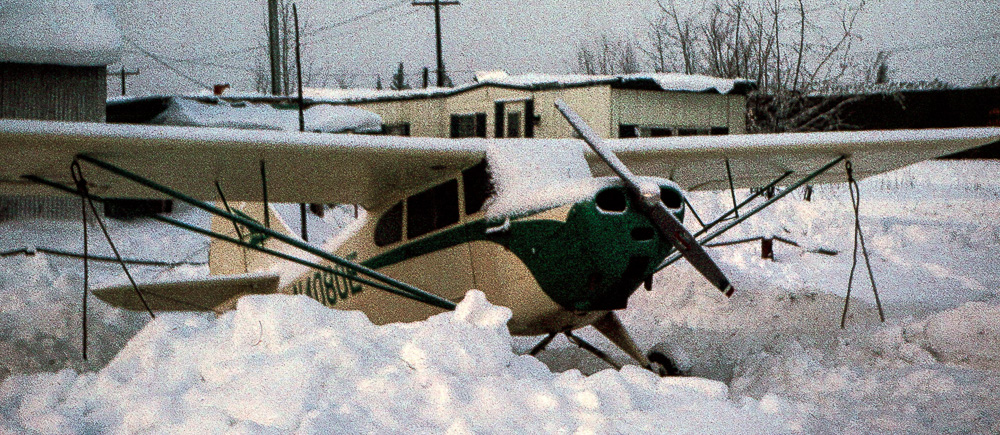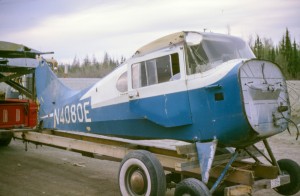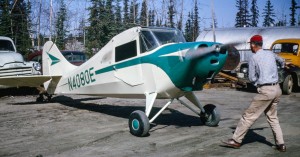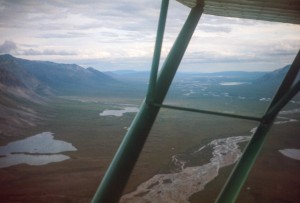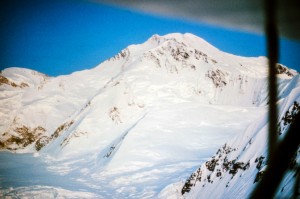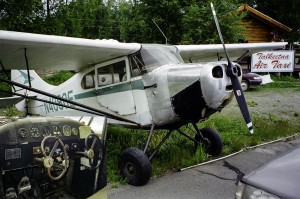She was only sixteen, but her paint was faded, her tailwheel smashed, and mice nested in her belly. She had suffered a hard landing in a farmer’s field near Delta Junction, and there she lay for three Alaska winters until my father rescued her in 1963. Fourteen months of his loving attention restored the 1947 Aeronca Chief to like-new condition.
That fall I was off to college in Seattle, where I started flying lessons.
The following summer, 1965, I worked at Mount McKinley National Park (now Denali) and escaped to Fairbanks on weekends to finish my flight training. My father, bless his heart, gave me full use of the airplane. So, with twenty hours in my logbook I was exploring interior Alaska, and with forty hours by the beginning of August, I took the check ride for my license.
I was back the next summer working at McKinley, trying to get into Fairbanks on weekends. There were no girls involved, just an airplane. A very basic airplane the Chief was, too, with two seats, no electrical system, no starter, no radios. We navigated by looking out the window at scenery that passed at 65 knots on a good day. “She sure flies in one place a long time,” my dad used to say.
I was able to keep the Chief with me at McKinley for a couple of weeks that summer, so I explored some remote areas from there by air. Teenagers know they are indestructible so I gave little thought to what I would do if I landed out somewhere with no radio and no one knowing where I went. Back then the usual climbing route on McKinley was from the north, so I followed it as far as I could up the Muldrow Glacier until, at 10,000 feet, the Chief would go no higher. I slipped out through McGonagall Pass, dropped down to Wonder Lake, and skimmed the tundra back to the park’s only air strip. It takes a lot of stupidity to amuse a teenager, too.
Not all my amusement was that dumb, though. A friend and I once dropped rolls of TP from 1000 feet expecting glorious streamers to the ground. All we got was full rolls of TP plopping into the Yukon River.
I felt oddly attracted to native villages—they all had some sort of airstrip—and visited them up and down the Yukon and Tanana Rivers: Manley, Stevens, Ft. Yukon, Minto, Rampart, all home to Athabaskan Indians. At one the mosquitoes were so ferocious that Robert and I got no further than a wingtip before retreating to the safety of the Chief. We stared at each other a bit before flipping a coin to see who scrambled out to swing the prop so we could leave. Only once did I visit an Eskimo village, Anaktuvuk Pass, then the sole remaining cluster of inland Eskimos, Nunamiut, in Alaska—the subject of another post.
I returned to Fairbanks the following summer, but for only two weeks before returning to Seattle for summer classes. I flew the Chief for the last five times, including a trip to Ft. Yukon with Käna Van Pelt, a high school friend I’d bumped into at the airport. What a sport! How many girls would answer “Yes” to “Wanna go visit a native village tonight?”
Dad also flew the Chief for the last time that summer, 1967. Fairbanks flooded in August and the Chief suffered damage. He sold her.
The Chief passed through other hands after that and whenever I visited Alaska from my home in California I would first check the aircraft registry to see where she was and would visit her if at all convenient. Some time in the 80s she was in Glenallen, where I found her, looking good, at the airport. By 1993 she was in Talkeetna, where Paul Roderick of Talkeetna Air Taxi used her on floats and skis. On Mt. McKinley she could only get airborne by taking off downhill, he said.
I visited her again in Talkeetna in the summer of 2000 and was saddened by what I saw. Airplanes are seldom pampered in Alaska and the Chief bore evidence of thirty-six years of hard work and no shelter. Her engine was worn out and any signs of her youth had flaked or fallen off, but she still showed most of the fabric and paint my father had given her in 1964.
The Chief was truly a magic carpet for me. She was last registered in Bethel, Alaska, but is no longer. I imagine her once again abandoned in another field, perhaps like the one my father rescued her from fifty-two years ago.

